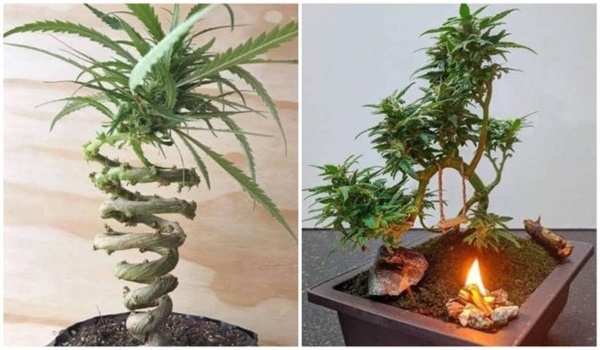Bonsai is an ancient technique that aims at growing trees at a small size. Many own their cannabis-bonsai tree at home, and here is how you can grow it too!
If you like adding some green to your living space and enjoying the benefits of indoor plants, we have something spectacular for you- a Bonsai tree!
Bonsai trees are perfect for our modern limited living spaces, as they are amazing space-savers!
To clarify things, a bonsai tree is not a specific species, but the term actually refers to the growing technique used to keep trees at this small size.
Namely, the goal is to develop a mature and healthy plant that will grow to only a fraction of its natural size. This technique requires careful grooming, and you can use nearly any tree type.
The practice is over a millennium old, and it originates from ancient Japan and China.
The word “bonsai” means “planted in a container”, as the miniature size is acquired by planting the trees in small containers, which impacts the size of the root systems, and thus in turn affects the ability of the plant to absorb nutrients.

Have you heard of the Cannabis-bonsai tree?
Yup, and you can now plant it at home!
Here is how to grow your own Cannabis-bonsai tree:
- Prepare a suitably small pot, and drill holes around the perimeter of the pot for string or twine.
- Set the mother plant in the pot. It should be healthy and sturdy. You can take clippings from the plant several times annually, so the mother should be capable of producing quality buds.
- Place a wooden stake to help train the plant’s main stem and position the trunk of the bonsai in a preferred way. To avoid damage, gently press the stake into the soil alongside the stem. Tie the stem to the stake and the drills in the pot using string or twine.
- Tie the branches down with twine to train them in the same way you trained the stem. Use more force to tie them down if you want them to be more horizontal, and leave them loose if you prefer them vertical.
- Prune the offshoot branches to preserve the shape and stature of your plant, allow for better airflow through the branches, and avoid mold growth by preventing humidity within the plant. Do not cut the main ones, in order not to damage the entire plant.
- The plant will produce white buds in the flowering stage, so you should trim them off, and leave them in a well-ventilated room to dry. Store them in an air-tight jar in a dark place. When they are half-dry, you can harvest them.

After you have harvested the buds, you can keep the plant as a decoration, and put it into a vegetative stage so it can flower again.
Leave the small buds on the bottom third of the tree, as you’ll need them for the plant’s regeneration process.
To move into the vegetative stage, the bonsai needs to be exposed to light 18 hours daily, and a large amount of nitrogen. Water it only when the soil is dry.
You can technically keep the plant as long as it is alive, as canna-bonsais are held indefinitely in the vegetative stage. Many claim that pure indicas degrade quicker and pure sativas last longer.
Yet, we can give you a useful time-frame: replace indicas every 3-4 years, hybrids every 4–5 years, and sativas every 5–6 years.
Due to their short stature, the following cultivars are most suitable for growing into Cannabis-bonsai trees:
-White Widow- This is a Dutch classic, and you cannot go wrong with it. It is a well-balanced hybrid that offers a combination of sativa and indica effects, and features soaring THC levels of over 20%.
-Critical Kush- This indica-dominant hybrid grows short and bushy. It is high in THC and offers potent relaxing and sedative properties.
The following Cannabis-bonsai trees are inspiring:







